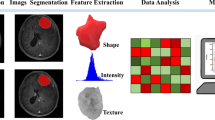Abstract
Preoperative identification of high-recurrent pediatric meningiomas with MRI features would help clinicians to make optimal treatment strategies; however, the relationships between radiological features and recurrence of meningiomas in pediatric population have not been clearly demonstrated yet. The aim of this study is to identify preoperative MRI features which are significant risk factors for recurrence of pediatric meningiomas. From January 2005 to December 2012, we retrospectively reviewed 52 pediatric meningiomas in terms of preoperative MRI features and their clinical data and followed them up from 22 to 128 months (mean 63 months) after the initial surgery. The relationships between these radiological findings and relapse-free survival (RFS) time were assessed initially with univariate Cox analysis and then corrected by multivariate Cox analysis. According to univariate analysis, irregular shape, narrow-based attachment, and skull base location were significantly correlated with shorter time to recurrences of meningiomas in pediatric patients. When corrected by multivariate analysis, irregular shape (P = 0.05; OR 3.442, 95 % CI 1.001–11.831) and narrow-based attachment (P = 0.004; OR 7.164, 95 % CI 1.894–27.09) were strong independent predictive factors for worse RFS of pediatric meningiomas. In pediatric population, narrow-based attachment and irregular shape were significantly correlated with recurrences of meningiomas. Our results could help clinicians to make optimal therapeutic strategies for pediatric patients with intracranial meningiomas before surgery.



Similar content being viewed by others
References
Tufan K, Dogulu F, Kurt G et al (2005) Intracranial meningiomas of childhood and adolescence. Pediatr Neurosurg 30:1–7
Kotecha RS, Pascoe EM, Rushing EJ et al (2011) Meningiomas in children and adolescents: a meta-analysis of individual patient data. Lancet Oncol 12:1229–1239
Bon-Jour L, Kuan-Nein C, Hung-Wen K et al (2014) Correlation between magnetic resonance imaging grading and pathological grading in meningioma. J Neurosurg 121:1–8
Kawahara Y, Nakada M, Hayashi Y et al (2012) Prediction of high-grade meningioma by preoperative MRI assessment. J Neuro-Oncol 108:147–152
Pendl G, Eustacchio S, Unger F (2001) Radiosurgery as alternative treatment for skull base meningiomas. J Clin Neurosci 8:12–14
Hwang WL, Marciscano AE, Niemierko A (2015) Imaging and extent of surgical resection predict risk of meningioma recurrence better than WHO histopathological grade. Neuro-oncology 2015
Nakasu S, Nakasu Y, Nakajima M et al (1999) Preoperative identification of meningiomas that are highly likely to recur. J Neurosurg 90:455–462
Rosenberg LA, Prayson RA, Lee J et al (2009) Long-term experience with World Health Organization grade III (malignant) meningiomas at a single institution. Int J Radiat Oncol Biol Phys 74:427–432
Tadashi O, Masahiko T, Masaya N et al (2013) Factors affecting peritumoral brain edema in meningiomas: special histological subtypes with prominently extensive edema. J Neuro-Oncol 111:49–57
Chiechi MV, Smirniotopoulos JG, Mena H (1996) Intracranial hemangiopericytomas: MR and CT features. Am J Neuroradiol 17:1365–1371
Arivazhagan A, Devi BI, Kolluri SV et al (2008) Pediatric intracranial meningiomas—do they differ from their counterparts in adults? Pediatr Neurosurg 44:43–48
Maier H, Ofner D, Hittmair A et al (1992) Classic, atypical, and anaplastic meningioma: three histopathological subtypes of clinical relevance. J Neurosurg 77:616–623
Ayerbe J, Lobato RD, Cruz JDL et al (1999) Risk factors predicting recurrence in patients operated on for intracranial meningioma. A multivariate analysis. Acta Neurochir 141:921–932
Rushing EJ, Cara O, Hernando M et al (2005) Central nervous system meningiomas in the first two decades of life: a clinicopathological analysis of 87 patients. J Neurosurg 103:489–495
Dietemann JL, Heldt N, Burguet JL et al (1982) CT findings in malignant meningiomas. Neuroradiology 23:207–209
Takeguchi T, Miki H, Shimizu T et al (2003) Prediction of tumor-brain adhesion in intracranial meningiomas by MR imaging and DSA. Magn Reson Med Sci Mrms Off J Jpn Soc Magn Reson Med 2:171–179
Hashiba T, Hashimoto N, Maruno M et al (2006) Scoring radiologic characteristics to predict proliferative potential in meningiomas. Brain Tumor Pathol 23:49–54
Mahmood A, Caccamo DV, Tomecek FJ et al (1993) Atypical and malignant meningiomas: a clinicopathological review. Neurosurgery 33:955–963
Sade B, Chahlavi A, Krishnaney A et al (2007) World Health Organization Grades II and III meningiomas are rare in the cranial base and spine. Neurosurgery 61:1194–1198
Pendl G, Eustacchio S, Unger F et al (2001) Radiosurgery as alternative treatment for skull base meningiomas. J Clin Neurosci 8:12–14
Mantle RE, Lach B, Delgado MR et al (1999) Predicting the probability of meningioma recurrence based on the quantity of peritumoral edema on computerized tomography scanning. J Neurosurg 91:375–383
Domingues PH, Sousa P, Otero Á et al (2014) Proposal for a new risk stratification classification for meningioma based on patient age, WHO tumor grade, size, localization, and karyotype. Neuro-Oncology 16:735–747
Andrej V, Mara P, Andrej C et al (2010) Mitotic count, brain invasion, and location are independent predictors of recurrence-free survival in primary atypical and malignant meningiomas: a study of 86 patients. Neurosurgery 67:1124–1132
Ildan F, Erman T, Göçer AI et al (2007) Predicting the probability of meningioma recurrence in the preoperative and early postoperative period: a multivariate analysis in the midterm follow-up. Skull Base Surg 17:157–171
Yamasaki F, Yoshioka H, Hama S et al (2000) Recurrence of meningiomas. Cancer 89:1102–1110
Nakasu S, Nakajima M, Matsumura K et al (1995) Meningioma: proliferating potential and clinicoradiological features. Neurosurgery 37:1049–1055
Acknowledgments
We would like to thank Dr. Yong Jiang for his assistance in statistical analysis.
Author information
Authors and Affiliations
Corresponding authors
Ethics declarations
Conflict of interest
The authors declare that they have no conflict of interest.
Rights and permissions
About this article
Cite this article
Li, H., Zhao, M., Wang, S. et al. Prediction of pediatric meningioma recurrence by preoperative MRI assessment. Neurosurg Rev 39, 663–669 (2016). https://doi.org/10.1007/s10143-016-0716-9
Received:
Revised:
Accepted:
Published:
Issue Date:
DOI: https://doi.org/10.1007/s10143-016-0716-9




